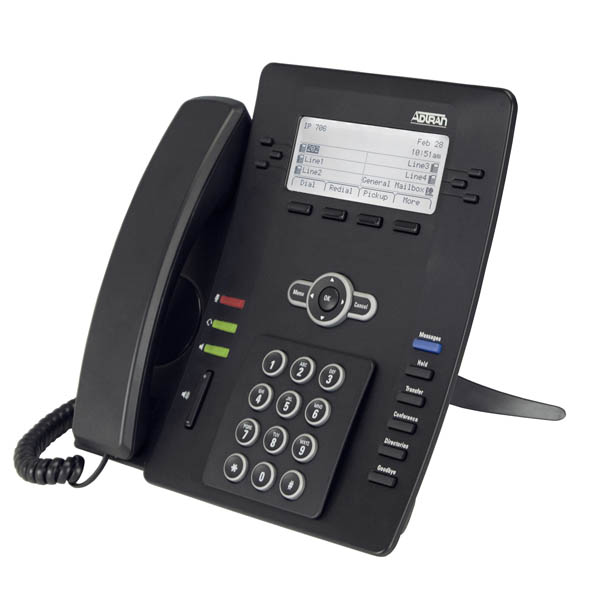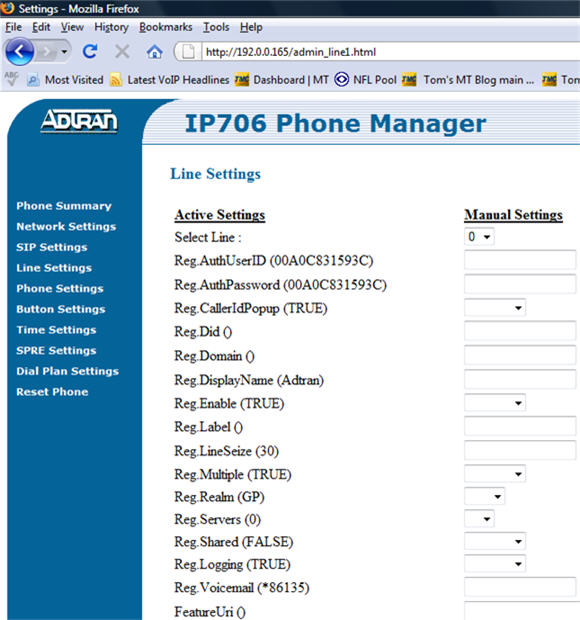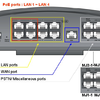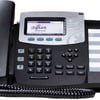
Adtran recently launched their IP 700 series of IP phones in late April. Adtran sent TMC Labs the IP 706 model, which supports up to 6 lines, but the 700 series also includes the IP 712 which is identical feature-wise but supports up to 12 lines. Each line can be configured to register with unique SIP proxy/registrar servers. This allows a different line for every line key on the phone. A line is called a multiple call appearance (MCA) type if it will be assigned to one or more line keys on the same phone. It is called a shared call appearance (SCA) type if the line is shared across multiple phones. This is not to be confused with SLA (Shared Line Appearance) which maps PSTN lines to buttons on all the phones. Of course you need to assign two lines with the same SIP credentials to two different lines (MCA) for full call handling functionality.
Like most if not all IP phones these days, the IP 706 supports 802.3af Power over Ethernet (PoE) as well as TFTP booting of firmware and configuration from a TFTP Server. The Adtran phone will connect to your TFTP Server (option 66 on DHCP server) and look for a file called adtran_[MAC address of Adran phone].txt. So for instance, for the IP 706 phone I tested, it looked for adtran_00a0c831593c.txt on the TFTP Server when the phone was booted.
The configuration files are pretty easy to figure out and sample files are available. For instance, one of the first things you'll want to do to configure any IP phone is to setup the dialplan. I was able to easily figure out how to setup the syntax for the Adtran dialplan, as seen here:
# DialPlanExternal is for realm GE line types and DialPlanPBX is for realm GP line types
DialPlanExternal |911|2-9]xxxxxx+T3|2-9]xx[2-9]xxxxxx|[0-1][2-9]xx[2-9]xxxxxx|011xxx+T3|xx+#
DialPlanPBX |911|9911|1-8]xxx|9[2-9]xxxxxx+T3|9[2-9]xx[2-9]xxxxxx|9[0-1][2-9]xx[2-9]xxxxxx|9011xxx+T3|*2-9]0123456789*]+T3|*1xx|#xx+#|xx+#|**xxxxThe web admin was pretty intuitive and can be used instead of a config file on a TFTP server. Here's a screenshot of a the web interface:

Want to specify a corporate directory? No problem. Just export a comma separated file containing your corporate directory, upload it to the TFTP server and then add this line to the Adtran config file:
SystemPhonebook adtran_phonebook.csv
I exported my Outlook Contacts to a CSV file, including first name, last name, company name, title, email, street, street2, street3, city, state, ZIP, country, mobile phone, home phone, FAX, with column/field headings in the first row. The IP 706 will read the first row to automatically map the contact data into the system phonebook. Once imported, you can scroll through the system directory using the 4-way navigation button. Holding the up/down arrow doesn't cause it to auto-repeat. Fortunately, you can press the left or right arrow to page up/down through the contacts. The 4-way navigation button also acts a shortcut buttons. When on the home screen you can press one of the four directions to access Incoming calls, Missed Calls, Placed calls, and the Personal address book. The detailed contact details is pretty cool, especially since most phones only store name and/or company and the phone number.
Defining buttons is pretty easy. Here's some examples from my config file:
Button.1.Label Line 1
Button.1.Type line
Button.1.Line 0
Button.2.Label Line 2
Button.2.Type line
Button.2.Line 0
Button.4.Label x149 Tom
Button.4.Type speed
Button.4.Number 149
Button.5.Label DND
Button.5.Type DND
Button.6.Label vm
Button.6.Type speed
Button.6.Number 8555Although the Adtran IP700 series was probably designed initially to work with the Adtran NetVanta 7060 and 7100, the Adtran IP700 series are SIP-based so the phones work with any SIP-based IP-PBX. I was able to register the phones on the Asterisk-based trixbox platform very easily. Once registered, I was able to make calls to Aastra and Polycom IP phones. The voice quality on both ends seemed very good. Usually the sound quality when using a handset is not an issue for any IP phone - it's when you try and use the speakerphone that sound quality issues arise. You need good echo cancellation to make sure the remote speaker's audio isn't fed back into the speakerphone. Polycom is renowned for their superior sounding voice quality in speakerphones, however, I was pretty impressed with the sound quality on the Adtran IP 706 when in speakerphone mode. The speakerphone volume when set to maximum is extremely loud and without any distortion. I doubt even in the largest of conference rooms that the loudest volume setting be required, but it's good to know it has the capability.
Overall, I like the button feel. not too hard, not too soft. Navigating the menus and options was very intuitive, though there is no key auto-repeat, which would be handy when scrolling quickly through the built-in directory book. Though, as I previously stated, you can use the left or right arrow to page up/down. The LCD was excellent - it's very bright and uses icons to indicate various features. For instance, a bell indicates your phone will ring, while an 'X' through the bell indicates DND mode. Similarly, a phone icon displays next to each line with or without an 'X' depending on if the line was registered with the SIP registrar or not. A U-turn arrow indicates a line is being forwarded. An envelope displays at the top of the phone if you have voicemail, along with the number of new messages. The phone has a slightly slow boot-up time taking 83s to fully boot. Comparatively, an Aastra 57iCT took 53s and a Polycom IP650 took 65s. Not a big deal, since you don't typically reboot your IP phone.
The Adtran IP phone supports busy lamp fields (BLF) using the Broadsoft method not the Sylantro method. This may be important if you are deploying Asterisk, since Asterisk only supports the Sylantro method. Personally, I have no need for BLF on our Asterisk-based IP-PBX, and no one in our office uses BLF, but certainly receptionists might find BLF useful. Other than the BLF feature, all other features worked on the trixbox system I was testing it with.
I was able to make outbound hands-free auto-answer intercom calls from the IP 706 to an Aastra phone. First I had to define the star code (*74) for initiating hands-free intercom calls. From the IP 706 I simply pressed the HFAAI (hands-free auto answer intercom) button on the LCD display under the More menu and dialed an extension which will immediately cause the remote phone to ring off-hook into hands-free speakerphone mode. You can also setup a speed dial for HFAAI so you don't have to go into the More submenu - a two step process.
Although outbound HFAAI calls from the IP 706 work, I wasn't able to get the Adtran phone to receive hands-free intercom calls from an Aastra phone. For instance, I made a from x149 Aastra phone to the IP 706, and although the IP 706 LCD displayed "Intercom - 149" it rang normally and did not go off-hook into speakerphone. I have to lift the receiver or press the speakerphone button to answer the call. I contacted Adtran technical support and they were quickly able to determine the issue. The phone responds to "alert-autoanswer" or "autoanswer" in the SIP header, so it's possible to tweak Asterisk to get it to work.
For speed dials, the Adtran IP phone supports 100 Personal and 300 System entries, no matter how many fields are in each record. You can even enter in pauses for speed dials with a "P" for a 2 second pause, useful for dialing through auto-attendants to an extension (i.e. 98005551234PP100).
In addition, you can export Outlook Contacts into a CSV file and put the CSV file on the TFTP server, which will be the global (not personal) system phonebook. You can also import a .CSV file directly to the phone via the phone's Web interface for your own personal phonebook and speed dials. The personal contact directory can be imported from the personal web GUI. You log into http://x.x.x.x/admin for the admin GUI, but just log into http://x.x.x.x for the user GUI. It allows for the upload (append or replace), and backup of the personal directory. The format is the same as the System Directory csv file.

Users can even enable call forwarding from the phone's web configuration. This is useful for when the IP-PBX doesn't support call forwarding. It even supports forwarding to an outside number.
From the phone itself you can test the audio of the handset speaker and the phone speakerphone. You can set the input to the handset microphone and have the output directed to the handset speaker or the speakerphone. Further you can test the button LEDs by turning them all on and you can test the LCD on the phone. Adtran claims that the IP700 series draws less than 6.49 watts of power under normal operating conditions. I was going to test it with my Kill a Watt electric meter, but I seemed to have misplaced it.
One nicety is you can modify the splash screen simply by downloading a 216x336 pixel 16-bit bitmap file to the parameter IconPixmap. This might be useful for OEMs or even IP-PBX vendors that want to do branding.
On inbound calls, the blue Messages light flashes, which is the button used to check your voicemail. You can't press the flashing Messages button to answer the call on speakerphone mode. I would prefer that it flash the speakerphone button instead. The reason is that when I first hooked it up and called it for the first time, I instinctively pressed the Messages button since it was flashing and I wanted to answer it via speakerphone mode. A minor complaint for sure.
Another test I performed was redirecting an inbound call to voicemail. You have a couple options. First, you can simply click 'Ignore' on the LCD and that will simply mute the ringing, but the caller has to wait until the ring duration setting has been met before going to voicemail. The proper way is to press the 'Vmail' icon on the LCD which will redirect the caller to the voicemail system. When I first attempted this, it sent the caller into the voicemail logon asking the caller for their extension and password. After perusing through the Admin Guide, it seemed like I had the voicemail settings correct. But then I realized I needed to do a call transfer direct to voicemail (*86 code) to the phone's extension (135). So I needed the *86 code. I simply needed these two lines in the Adtran config file:
MessagesCallback 8555 # For 1-button access to check voicemail
Reg.0.Voicemail *86135 # For redirecting callers to voicemail.The phones include an adjustable desk stand or can be wall mounted. An integrated headset jack with electronic hook-switch eliminates the need for a mechanical handset lifter. The electronic hook switch is compatible with GN Netcom and Plantronics headsets.
Features:
- Adaptive jitter buffers and packet loss concealment algorithms
- Six programmable buttons
- Large backlit display, with 6 rows by 35 characters (IP 706), 9 rows by 35 characters (IP 712)
- Message waiting indicator
- Four-way navigation
- 802.3af Power over Ethernet (PoE)
- Integrated headset jack
- Distinctive ring tones by number
- Multiple call appearances
- Three-way conferencing
- Busy Lamp Field (BLF)
- Shared Line Appearance (SLA)
- Hands-free auto-answer intercom
- Distinctive incoming call treatment/call waiting
- Visual ringing alert/message waiting indicator
- Voice activity detection and comfort noise fill
- Full-duplex speaker phone
- Three-way conferencing
- G.711u, G.711a, G.729A (Annex B)
|
Pricing: The Adtran IP 706 is $249 and the Adtran IP 712 is $299.
Conclusion
I like the aesthetics of the IP 706. It's a nice clean design with a bright LCD and it has a very intuitive navigation menu on the phone. Similarly, the web interface was easy enough to navigate and figure out. The adaptive jitter buffers and packet loss concealment algorithms are a nice addition to ensure voice quality. A way of importing personal contacts into the phone itself via the web interface would be nice, but I do like that the Adtran speed dials support pauses - not all IP phones do, which makes them less useful when dialing auto-attendants with extensions. Overall, I was pretty pleased with the Adtran IP 706's style, performance, and features. Customers have yet another choice when choosing a SIP-based IP phone. Watch out Aastra, Grandstream, Linksys, Polycom, and Snom - there's a new IP phone in town!













